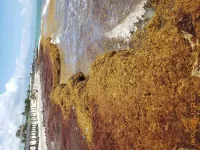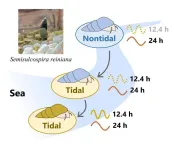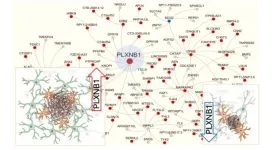(Press-News.org) Researchers have been working to track and study floating sargassum, a prolific seaweed swamping Caribbean and West African shorelines, and causing environmental and economic harm.
The stranded seaweed blocks fishing boats; threatens tourism; disrupts turtle nesting sites, reefs and mangroves, and releases toxic gas, which impacts human health and damages electrical equipment.
First reported by Christopher Columbus in the 15th century, floating mats of sargassum have long been present in the North Atlantic. However, since 2011, a floating population has established between West Africa and South America, and increased in size to form “the great Atlantic sargassum belt” – a 9,000km-long macroalgal bloom, visible from space and estimated to weigh 35 million tons.
The massive blooms of sargassum are thought to be down to nutrient pollution and warming seas, and vast quantities of the seaweed end up in landfill each year.
The research team, from the Universities of York and Southampton, alongside colleagues from the University of the West Indies in Jamaica and Barbados, set out to learn more about sargassum’s biomass composition in order to unlock its potential to be used to produce sustainable products.
While the seaweed is an abundant biomass, its possible uses are limited due to its high arsenic content.
First author of the study Dr Carla Machado, a research associate in the Department of Biology, said: “The small quantities of sargassum that used to wash ashore in the Caribbean provided a habitat for turtles, crabs and fish and contributed to beach formation as it decomposed, but the vast sargassum blooms of the past decade are a global problem that will continue to grow and have a major impact in the affected countries.
This research project has brought together international researchers specialising in biomass composition and satellite imaging to track, sample and study sargassum, providing crucial new knowledge of this little-understood macroalgae.”
For a biomass to be utilised, it needs to be consistent in its composition; this ensures it can be processed efficiently and behave predictably during production.
The results of the study showed that, overall, the biochemical composition of sargassum is consistent throughout the year. The researchers tested different processing methods for the seaweed, including shade-drying or freezing, and found the protein content of the seaweed stayed the same. However, the method of processing did affect levels of other components such as alginate, which can be processed for many applications, including biomaterials.
The researchers collected samples of sargassum in Jamaica throughout 2021, which coincided with the April 2021 eruption of La Soufrière on the Caribbean island of Saint Vincent.
Using drift patterns, the authors calculated that the sargassum samples they collected in August 2021 would have spent approximately 50 days exposed to ash from the eruption.
They found that seaweed that had likely been in contact with volcanic ash contained less arsenic, but had accumulated other elements including nickel and zinc.
Lead author of the study, Dr Thierry Tonon from the Department of Biology at the University of York said: “Understanding sargassum’s response to environmental conditions is crucial for unlocking its biology and potential value.
“With the great sargassum belt also receiving additional nutrients from Sahara dust that blows across the Atlantic, huge quantities of the seaweed washing up on coastlines looks set to become the new normal.”
There is much more work to be done to increase understanding about sargassum and how it is going to behave in years to come, the researchers say. This will provide a body of evidence that could inform an international response to the problems it poses to people and the environment and transform it into something useful.
Professor Robert Marsh from the University of Southampton said: “The sargassum beaching around Jamaica in late summer 2021 carried distinct traces of the volcanic ash that settled upon it around 4 months earlier, just to the east of St Vincent; this novel ‘volcanic tag’ confirmed that sargassum arrives each summer at Jamaican beaches after a months-long journey drifting with currents from the central tropical Atlantic.”
Professor Hazel A. Oxenford from the University of the West Indies said: “Volcanic ash collected in my garden from the St Vincent eruption was used to determine its chemical signature. Being able to detect those components in sargassum after it travelled more than 1,700 km across the Caribbean to Jamaica was exciting. It confirmed our predicted transport pathway for sargassum, showed that the seaweed lives for at least 4 months and demonstrates the marine connectivity across the region.”
Professor Mona Webber from the University of the West Indies added: “It is very important for Caribbean Islands being affected by the sargassum inundation to be able to benefit from its valorization. Understanding how the sargassum we collect in Jamaica has changed en route to our shores and factors that could affect especially the arsenic content, will propel us towards safe use of the algal biomass.”
Changes in holopelagic Sargassum spp. biomass composition across an unusual year is published in the Journal PNAS. The study was carried out in collaboration between the Universities of York, Southampton and the West Indies.
END
Secrets of sargassum: Scientists advance knowledge of seaweed causing chaos in the Caribbean and West Africa
Researchers have been working to track and study floating sargassum, a prolific seaweed swamping Caribbean and West African shorelines, and causing environmental and economic harm
2024-05-27
ELSE PRESS RELEASES FROM THIS DATE:
Bioinformatics approach could help optimize soldiers’ training for improved readiness and recovery
2024-05-27
Of the many perils facing members of the military, injuries incurred in training or on deployment repeatedly sideline elite operators.
“It’s a pervasive problem,” says Dhruv Seshadri, an assistant professor of bioengineering in Lehigh University’s P.C. Rossin College of Engineering and Applied Science. “We’re looking at how we can integrate physiological data, biomechanical data, and subjective assessments to help reduce the risk of these injuries happening in the first place, and when they do happen, how we can use those data to accelerate the soldier’s return to operation.”
Seshadri ...
Earth scientists describe a new kind of volcanic eruption
2024-05-27
No two volcanic eruptions are exactly alike, but scientists think a series of explosive eruptions at Kīlauea volcano fit into a whole new category.
By analyzing the dynamics of 12 back-to-back explosions that happened in 2018, researchers describe a new type of volcanic eruption mechanism. The explosions were driven by sudden pressure increases as the ground collapsed, which blasted plumes of rock fragments and hot gas into the air, much like a classic stomp-rocket toy.
Researchers from the University of Oregon, United States Geological Survey and China’s Sichuan University report their findings in a paper published May 27 in Nature Geoscience.
The ...
Warmer wetter climate predicted to bring societal and ecological impact to the Tibetan Plateau
2024-05-27
While recent reports have stated that more than half the world’s largest lakes, including lakes in the Tibetan plateau, are drying up, a paper in Nature Geoscience today (27/5/24 DOI 10.1038/s41561-024-01446-w ) suggests that, by the end of this century, land-locked lakes on the Tibetan Plateau are set to increase exponentially, resulting in major land loss and related economic, environmental and climatic impacts.
Climate and weather predictions suggest that increased rainfall due to climate change will enlarge these lakes, and see water levels rise by up to 10 metres.
The volume of water caught in these land-locked lakes is estimated to ...
Feeding infants peanut products protects against allergy into adolescence
2024-05-27
Feeding children peanuts regularly from infancy to age five reduced the rate of peanut allergy in adolescence by 71%, even after many years when the children ate or avoided peanut as desired.
The new findings provide conclusive evidence that introducing peanuts into babies’ diets early will achieve long-term prevention of peanut allergy.
Lead investigator Professor Gideon Lack from King’s College London said: “Decades of advice to avoid peanuts has made parents fearful of introducing peanuts at an early age. The evidence is clear that early introduction of peanut in infancy ...
Who will like beetle skewers? What Europeans think about alternative protein food
2024-05-27
Why do people in Paris like seaweed and tofu salad? Will Italians be tempted to try a beetle skewer? How many young Polish consumers are "food innovators", eager to eat chickpea pâté? In an international project, researchers from SWPS University analysed European consumers' attitudes towards alternative protein food products.
In the face of the fight against climate change, more and more people are modifying their diets, giving up or limiting conventional sources of protein (e.g., beef, pork, poultry, and animal dairy) in favour of those with a lower environmental impact. These are the so-called alternative protein food (APF) products, which may be based on ...
ETRI wins ‘iF Design Award’ for mobile collaborative robot
2024-05-27
ETRI research team has won a main prize at the German International Design Competition, one of the top three design award competitions in the world. This signifies global recognition of our research team’s technology.
Electronics and Telecommunications Research Institute (ETRI) announced that its Teach Pendant software for the autonomous mobile collaborative robot (MOBY1)) won the main prize in the User Experience (UX2)) category at the ‘iF Design Award 20243)’, an international design competition in Germany.
1) MOBY: Equipped with the AI-based vision solution ‘IndyEye’ and the ...
Combating carbon footprint: novel reactor system converts carbon dioxide into usable fuel
2024-05-27
Reducing carbon emissions from small-scale combustion systems, such as boilers and other industrial equipment, is a key step towards building a more sustainable, carbon-neutral future. Boilers are widely used across various industries for essential processes like heating, steam generation, and power production, making them significant contributors to greenhouse gas emissions.
Boilers are generally quite efficient. As a result, it is difficult to reduce CO2 emissions simply by improving the combustion efficiency. Therefore, researchers are exploring alternative approaches to mitigating the environmental ...
Investigating the origin of circatidal rhythms in freshwater snails
2024-05-27
Organisms, including humans, follow a schedule that coordinates important bodily functions such as sleep-wake cycles, metabolism, hormone production, cognitive function, and feeding habits to environmental cycles. While most organisms possess circadian rhythms synchronized with the 24-hour day-night cycle, they have also developed other internal clocks to suit their local environments. Marine animals have evolved circatidal rhythms, aligning activities with the 12.4-hour tidal cycle, complementing circadian rhythms.
Researchers from Chiba University have discovered that snails living in downstream tidal areas have biological ...
Altering cellular interactions around amyloid plaques may offer novel Alzheimer’s treatment strategies
2024-05-27
New York City, [May 27, 2024] – Researchers at the Icahn School of Medicine at Mount Sinai have made a significant breakthrough in Alzheimer’s disease research by identifying a novel way to potentially slow down or even halt disease progression. The study, which focuses on the role of reactive astrocytes and the plexin-B1 protein in Alzheimer's pathophysiology, provides crucial insights into brain cell communication and opens the door to innovative treatment strategies. It was published in Nature Neuroscience (DOI 10.1038/s41593-024-01664-w) on May 27.
This groundbreaking work is centered ...
Brain damage reveals part of the brain necessary for helping others
2024-05-27
Our willingness to help others is governed by a specific brain region pinpointed by researchers in a study of patients with brain damage to that region.
Learning about where in the brain ‘helping’ decisions are made is important for understanding how people might be motivated to tackle large global challenges, such as climate change, infectious disease and international conflict. It is also essential for finding new approaches to treating disorders of social interactions.
The study, ...
LAST 30 PRESS RELEASES:
Statins significantly reduce mortality risk for adults with diabetes, regardless of cardiovascular risk
Brain immune cells may drive more damage in females than males with Alzheimer’s
Evidence-based recommendations empower clinicians to manage epilepsy in pregnancy
Fungus turns bark beetles’ defenses against them
There are new antivirals being tested for herpesviruses. Scientists now know how they work
CDI scientist, colleagues author review of global burden of fungus Candida auris
How does stroke influence speech comprehension?
B cells transiently unlock their plasticity, risking lymphoma development
Advanced AI dodel predicts spoken language outcomes in deaf children after cochlear implants
Multimodal imaging-based cerebral blood flow prediction model development in simulated microgravity
Accelerated streaming subgraph matching framework is faster, more robust, and scalable
Gestational diabetes rose every year in the US since 2016
OHSU researchers find breast cancer drug boosts leukemia treatment
Fear and medical misinformation regarding risk of progression or recurrence among patients with breast cancer
Glucagonlike peptide-1 receptor agonists and asthma risk in adolescents with obesity
Reviving dormant immunity: Millimeter waves reprogram the immunosuppressive microenvironment to potentiate immunotherapy without obvious side effects
Safety decision-making for autonomous vehicles integrating passenger physiological states by fNIRS
Fires could emit more air pollution than previously estimated
A new way to map how cells choose their fate
Numbers in our sights affect how we perceive space
SIMJ announces global collaborative book project in commemoration of its 75th anniversary
Air pollution exposure and birth weight
Obstructive sleep apnea risk and mental health conditions among older adults
How talking slows eye movements behind the wheel
The Ceramic Society of Japan’s Oxoate Ceramics Research Association launches new international book project
Heart-brain connection: international study reveals the role of the vagus nerve in keeping the heart young
Researchers identify Rb1 as a predictive biomarker for a new therapeutic strategy in some breast cancers
Survey reveals ethical gaps slowing AI adoption in pediatric surgery
Stimulant ADHD medications work differently than thought
AI overestimates how smart people are, according to HSE economists
[Press-News.org] Secrets of sargassum: Scientists advance knowledge of seaweed causing chaos in the Caribbean and West AfricaResearchers have been working to track and study floating sargassum, a prolific seaweed swamping Caribbean and West African shorelines, and causing environmental and economic harm





